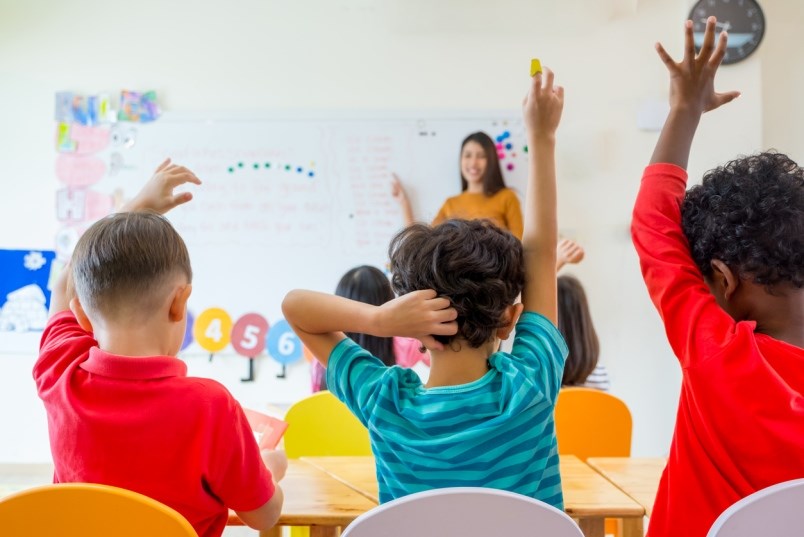Despite the risk to staffing levels in schools, the province made it clear Friday it intends to open schools for in-class learning next week and announced enhanced safety measures to try to keep the highly-infectious Omicron from crippling classrooms.
Three-layered masks for students and staff, virtual assemblies, staggered break periods and restrictions on school visitors will be put in place in B.C. schools as they province struggles to deal with the crisis.
Due to the alarming number of new cases attributed Omicron over the past few months and skyrocketing requests for testing which have overwhelmed medical labs, the province is changing how it reports school COVID exposures. Education Minster Jennifer Whiteside said because of the sheer number of active cases, individual case management and contact tracing are no longer helpful to track the spread of the virus.
Notifications will now only be issued if classroom attendance drops noticeably below typical levels. If there is an outbreak observed with multiple cases in a classroom or school, parents will still be advised in those instances.
Schools will have access to a shipment of rapid tests to use on teachers and staff showing symptoms of COVID-19 to help health authorities isolate outbreaks and clusters of cases of the virus. Provincial health officer Dr. Bonnie Henry said the testing program will eventually be expanded to students and their families as more test kits become available.
Amid criticism for the lack of rapid tests available to British Columbians, Henry said at Friday’s news conference in Victoria that a shipment from the federal government is expected next week. Henry said the province has received more than a million tests but the majority of them are not suitable for self-testing at home.
School staff have been on the job this week preparing enhanced safety plans during the phased restart of classrooms, which was delayed by a week for most K-12 students. Teachers have expressed worries there will not been enough staff to operate schools when they become sick and are forced to isolate at home for the required quarantine period. Administrators have been preparing phased closures of classrooms if staffing levels drop too low.
Joanne Hapke, president of the Prince George District Teachers’ Association, remains hopeful that will never come to pass. She encouraged that schools will re-open but says there should be more protections in place for students and staff.
“We’ve always said, kids learn best in school and teachers prefer to have the students in front of them in order to instruct,” said Hapke. “Zoom worked for that short period of time (from March-June 2020 when schools were closed during the lockdown) because it had to work. But it wasn’t ideal for anybody, so definitely we want our schools remaining open, but we also want our schools safe for the people who need to be there.”
Parents are being advised to provide students with three-layered masks and some will be made available at no charge at schools.
“What we are learning now is that N95 masks are what needs to be provided and available for staff in schools and should be available for students who are in attendance,” said Hapke. “Will they even be in schools on Monday when kids return?”
Teachers, learning assistants and support staff are in close proximity to students in the classrooms and Hapke says while most students have been complying with the province’s mask mandate, too many students are remaining unmasked during class time because they have medical or behavioural exemptions, and she said that puts staff at risk.
According to the B.C. Teachers’ Federation, just 23 per cent of children aged 5-11 in the Northern Health region are vaccinated with a first dose, as compared to 53 per cent in Vancouver Coastal.
Hapke says teachers should be prioritized to receive booster shots regardless of which age cohort they belong to. She added that added layer of protection is even more critical in the cold-winter climates of north central B.C., where most schools lack modern air filtration systems and it’s too cold outside to open windows to let in fresh air, which adds to the threat of virus transmission.
“Staggered recess and staggered lunch is absolutely a change, but a virtual assembly is not going to protect us from five unmasked children in our classroom for six or seven hours a day,” Hapke said. “Parents were taking advantage of these exemptions and kids began taking advantage of the exemptions and stopped wearing them. We had multiple teachers, especially in high schools, reporting to us that those mask exemptions made the mask mandate ineffectual. Once you give somebody an out, they’re going to take it.”
The shortage of test kits is keeping the number of new cases in the Northern Health region lower than what the actual numbers are, suggests Hapke. She knows of one teacher who missed the entire week of work and was told the earliest time they could get tested was on Saturday. Knowing how widespread the virus has become, she urges students and school staff to do daily health checks and watch for COVID symptoms and stay home in isolation if they notice any signs of the virus, such as cold/flu-like symptoms, tiredness, fever, cough, loss of sense of smell or taste.
“If you have any symptoms at all no matter how minor, stay home until the symptoms are gone,” said Hapke. “If you have COVID symptoms, assume you have COVID, that’s how fast Omicron is spreading. If you just stay home until you’re better, that’s the best thing you can do right now. But what we’re hearing is even healthcare professionals are receiving the advice that if you’re self-isolating you can still go to work and your children can still go to school. What is that?”



